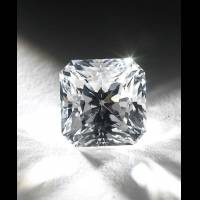Apophyllite Group

India
22.91 carats
Apophyllite is popular because of its abundance, colour variety, and well-defined crystals, but easy cleavage, brittleness and extreme heat sensitivity make this material difficult to facet.
Apophyllite Group Gemstones by Colour
This table shows the variety of hues this gemstone can be found in. Click on a photo for more information.
Apophyllite Group Gemstones by Size
This table shows distribution of Apophyllite Group gemstone sizes that are listed on this site. This can give a good indication as to the general availability of this gemstone in different sizes.
Contributed photos
Lightest:3.04 cts
Heaviest:22.91 cts
Average:9.23 cts
Total photos:6
Do you have a larger Apophyllite Group? Why not upload a photo?
| General Information | ||||||||||||||||||
|---|---|---|---|---|---|---|---|---|---|---|---|---|---|---|---|---|---|---|
| Chemical Formula |
| |||||||||||||||||
| Apophyllite Group Treatments | ||||||||||||||||||
| Colorless material has been reported by Plough (1957) to turn green on irradiation. Heat could be expected to reverse this change - Nassau, 1984 | ||||||||||||||||||
| Physical Properties of Apophyllite Group | ||||||||||||||||||
| Mohs Hardness | 4.5 to 5, Blue Chart Gem Identification (2010) More from other references | |||||||||||||||||
| Specific Gravity | 2.30 to 2.50, Gemstones of the world (2001) More from other references | |||||||||||||||||
| Cleavage Quality | Perfect, Blue Chart Gem Identification (2010) Easy and perfectMore from other references | |||||||||||||||||
| Fracture | Uneven, Gemstones (2009) | |||||||||||||||||
| Optical Properties of Apophyllite Group | ||||||||||||||||||
| Refractive Index | 1.530 to 1.543, Blue Chart Gem Identification (2010) More from other references | |||||||||||||||||
| Optical Character | Uniaxial/+,-, Blue Chart Gem Identification (2010) More from other references | |||||||||||||||||
| Birefringence | 0.000 to 0.003, Blue Chart Gem Identification (2010) More from other references | |||||||||||||||||
| Dispersion | High, Gemstones (2009) | |||||||||||||||||
| Colour | ||||||||||||||||||
| Colour (General) | White, colourless, bluish, reddish, yellowish, greenish, Gemmological Tables (2004) More from other references | |||||||||||||||||
| Causes of Colour | Green, V4+ in distorted octahedral coordination, Pragmatic Spectroscopy For Gemologists (2011) | |||||||||||||||||
| Transparency | Transparent,Translucent,Opaque, Gemmological Tables (2004) More from other references | |||||||||||||||||
| Lustre | Pearly, Blue Chart Gem Identification (2010) More from other references | |||||||||||||||||
| Fluorescence & other light emissions | ||||||||||||||||||
| Fluorescence (Long-Wave UV) | Blue-green and yellow, Gemstones (2009) | |||||||||||||||||
| Crystallography of Apophyllite Group | ||||||||||||||||||
| Crystal System | Tetragonal, Blue Chart Gem Identification (2010) More from other references | |||||||||||||||||
| Habit | Tabular, prismatic, pseudo-cubic, Gemstones (2009) | |||||||||||||||||
| Geological Environment | ||||||||||||||||||
| Where found: | Apophyllite occurs in basalts and granites, Gems, Sixth Edition (2006) | |||||||||||||||||
| Further Information | ||||||||||||||||||
| Mineral information: | Apophyllite Group information at mindat.org | |||||||||||||||||





